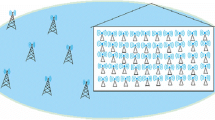Abstract
Femtocells provide indoor coverage for voice and high speed data services and are self-deployed by end-users. Orthogonal frequency code division multiplexing (OFCDM) is a multi-carrier spread spectrum technique that utilizes two dimensional spreading in time and frequency domains simultaneously to improve frequency diversity and minimize multiuser access interference. In this paper, variable spreading factor (VSF)-OFCDM is employed in subcarrier allocation for femto users (FUEs) in a hybrid femto/macro network, and the effect of FUE deployment on macro users (MUEs) is studied. We evaluate the bit error rate (BER) performance of FUEs and MUEs through Monte Carlo simulation under various load conditions in noise and interference-limited scenarios. Relationship between the channel load and optimum spreading factor employed by FUEs for the given network configuration, is also analyzed. We provide various graphs showing the impact of FUE spreading factor on the MUE BER. We note that in interference-limited conditions, \(4\times 8\) spreading \((\text{ time}\times \text{ freq}.)\) proves to be the best choice for macro users; and for the noise-limited case, when there are limited number of users and channel noise is dominant, \(2\times 16\) spreading is the optimum choice for the considered hybrid network configuration. We also evaluate the effect of femto wall penetration loss on macro BER for various spreading factors. The favorable spreading factor for MUEs is tabulated for different loads and different number of subcarriers, which can be used as a deployment guide in this heterogeneous network.














Similar content being viewed by others
References
Wang, L., & Zhang, Y. (2009). Mobility management schemes at radio network layer for lte femtocells. In IEEE vehicular technology conference (pp. 1–5).
Zhang, J., & de la Roche, G. (2010). Femtocells: Technologies and deployment. New York: Wiley.
Taha, H. J., Saleh, M. (2009). Multi-carrier transmission techniques for wireless communication systems: A survey. World Scientific and Engineering Academy and Society Transaction on, Communications, 8, 457–472.
Chandrasekhar, V., & Andrews, J. G. (2009). Spectrum allocation in tiered cellular networks. IEEE Transaction on Communication, 57, 3059–3068.
Lopez, D., & Zhang, J. (April 2010). OFDMA femtocells: A self-organizing approach for frequency assignment. In IEEE international symposium on personal, indoor and mobile radio communications (pp. 2202–2207).
Chang, C. (2012). An interference-avoidance code assignment strategy for the hierarchical two-dimensional-spread MC-DS-CDMA system: A prototype of cognitive radio femtocell system. IEEE Transaction on Vehicular Technology, 61, 166–184.
Wang, J., & Ching, W. (2010). The analysis of system performance of an MC-CDMA system over two-tier femtocell networks. IEEE International Multiconference of Engineers and Computer Scientists, 864–867.
Kim, R., & Etemad, K. (2009). WiMAX femtocell: Requirements, challenges and solutions. IEEE Communication Magazine, 47, 84–91.
Lopez, D., & Zhang, J. (September 2009). Limited access to OFDMA femtocells. In IEEE international symposium on personal, indoor and mobile radio communications (pp. 1–5).
Chu, X., & Lopez, D. (2011). On providing downlink services in collocated spectrum-sharing macro and femto networks. IEEE Transaction on Wireless Communication, 10, 4306–4315.
Chih-Lin, J., & Gitlin, R. (1993). A microcell/macrocell cellular architecture for low- and high-mobility wireless users. IEEE Journal on Selected Areas in Communication, 11, 885–891.
Lee, J. Y., & Chung, M. Y. (2011). Interference analysis for femtocell deployment in OFDMA systems based on fractional frequency reuse. IEEE Communication Letters, 15, 425–427.
Cao, G., & Zhang, X. (August 2011). An adaptive sub-band allocation scheme for dense femtocell environment. In IEEE, wireless communications and networking conference (pp. 102–107).
Crespo, C., & Agust, R. (2010). Self-optimization of spectrum assignment and transmission power in OFDMA femtocells. Advanced International Conference on Telecommunications (AICT) (pp. 404–409).
Das, S., & Chandhar, P. (December 2011). Issues in femtocell deployment in broadband OFDMA networks: 3GPP-LTE a case study. In IEEE vehicular technology conference (pp. 1–5).
Andrews, J. G., & Chandrasekhar, V., (November 2007). Uplink capacity and interference avoidance for two-tier cellular networks. In IEEE global telecommunications conference (pp. 3322–3326).
Xia, P., Chandrasekhar, V., & Andrews, J. G. (2010). Open vs. closed access femtocells in the uplink. IEEE Transaction on Wireless Communication, 9, 3798–3809.
Bao, L., & Kim, D. (September 2011). Distributed interference management in femtocell networks. In IEEE vehicular technology conference (pp. 1–5).
Zhou, Y., Wang, J., & Ng, T.-S. (October 2007). Two dimensionally spread OFCDM systems for 4G mobile communications. In IEEE Region 10 conference (TENCON) (pp. 1–4).
Maeda, N., Kishiyama, Y., Atarashi, H., & Sawashashi, M. (April 2003). Variable spreading factor-OFCDM with two dimensional spreading that prioritizes time domain spreading for forward link broadband wireless access. IEEE vehicular technology conference, 127–132.
Guvenc, I., & Kozat, C. (September 2009). Impact of spreading on the capacity of neighboring femtocells. In IEEE international symposium on personal, indoor and mobile radio communications (pp. 18147–1818).
Liu, T., & Vishwanath, S. (May 2008). Limits on cognitive communications in the wide-band regime. In IEEE international conference on cognitive radio oriented wireless networks and, communications (pp. 1–6).
Caldwell, R., & Anpalagan, A. (2008). Adaptive subcarrier allocation in synchronous reverse links of a multicarrier CDMA system with time and frequency spreading. IEEE Transaction on Vehicular Technology, 57, 1494–1501.
You, C., & Hong, D. (2003). Multicarrier CDMA systems using time-domain and frequency-domain spreading codes. IEEE Transaction on Communication, 51, 17–21.
Khalid, L., & Anpalagan, A. (2008). Performance analysis of a threshold-based group-adaptive modulation scheme with adaptive subcarrier allocation in OFCDM systems. IEE Transaction on Wireless Communication, 7, 2463–2467.
Yang, T., & Zhang, L. (2011). Approaches to enhancing autonomous power control at femto under co-channel deployment of macrocell and femtocell. In IEEE international symposium on personal indoor and mobile radio communications (PIMRC) (pp. 71–75).
Shi, Z., Wang, H., Zhao, M., & Reed, M. C. (2010). An uplink analytical model for two-tiered 3G femtocell networks. In International symposium on modeling and optimization in mobile, ad hoc and wireless networks (WiOpt), 367–372.
Author information
Authors and Affiliations
Corresponding author
Rights and permissions
About this article
Cite this article
Hussain, F., Anpalagan, A. & Kong, H.Y. Performance Analysis of Two Dimensional Spreading for OFCDM Femtocell Users Overlaid with OFDM Macrocell. Wireless Pers Commun 72, 137–158 (2013). https://doi.org/10.1007/s11277-013-1005-3
Published:
Issue Date:
DOI: https://doi.org/10.1007/s11277-013-1005-3




